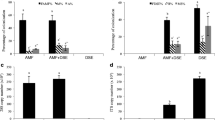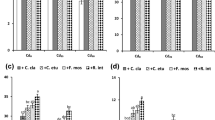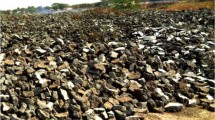Abstract
Arbuscular mycorrhizal fungi (AMF) alter heavy metal acquisition by higher plants and may alter plant response to soil-contaminating heavy metals. Two communities comprised of Glomus intraradices and G. spurcum were investigated for their influence on copper (Cu) and zinc (Zn) resistance of Sorghum bicolor. One community was isolated from a Cu- and Zn-contaminated soil (AMF-C) and one consisted of isolates from non-contaminated soil (AMF-NC). Non-mycorrhizal (NM) sorghum plants were also included. The two community ecotypes differed in their capacity to protect sorghum from Cu and Zn toxicity and exhibited differential metal uptake into hyphae and altered heavy metal uptake by roots and translocation to plant shoots. AMF-C reduced Cu acquisition under elevated Cu conditions, but increased Cu uptake and translocation by sorghum under normal Cu conditions, patterns not exhibited by AMF-NC or NM plants. Hyphae of both fungal ecotypes accumulated high concentrations of Cu under Cu exposure. AMF-C exhibited elevated hyphal Zn accumulation and stimulated Zn uptake and translocation in sorghum plants compared to AMF-NC and NM plants. Differences in metal resistance between fungal treatments and between mycorrhizal and non-mycorrhizal plants were not related to differences in nutrient relations. The enhanced Cu resistance of sorghum and altered patterns of Cu and Zn translocation to shoots facilitated by AMF isolated from the metal-contaminated soil highlight the potential for metal-adapted AMF to increase the phytoremediation potential of mycotrophic plants on metal-contaminated environments.
Similar content being viewed by others
References
Borkert, C. M., Cox, F. R. and Tucker, M. R.s: 1998, ‘Zinc and copper toxicity in peanut, soybean, rice, and corn in soil mixtures’, Commun. Soil Sci. Plant Anal. 29, 2991–3005.
Brown, S. L., Chaney, R. L., Angle, J. S. and Baker, A. J. M.: 1994, ‘Phytoremediation potential of Thlaspi caerulescens and bladder campion for zinc- and cadmium-contaminated soil’, J. Environ. Qual. 23, 1151–1157.
Bürkert, B. and Robson, A.: 1994, ‘65Zn uptake in subterranean clover (Trifolium subterraneum L.) by three vesicular-arbuscular mycorrhizal fungi in a root-free sandy soil’, Soil Biol. Biochem. 9, 1117–1124.
Buxton, D. R., Anderson, I. C. and Hallam, A.: 1998, ‘Intercropping sorghum into alfalfa and reed canarygrass to increase biomass yield’, J. Prod. Agric. 11, 481–486.
Cunningham, S. D. and Ow, D.: 1996, ‘Promises and prospect of phytoremediation’, Plant Physiol. 110, 715–719.
Ebbs, S. D. and Kochian, L. V.: 1997, ‘Toxicity of zinc and copper to Brassica species: Implications for phytoremediation’, J. Environ. Qual. 26, 776–781.
Fosmire, G. J.: 1990, ‘Zinc toxicity’, Am. J. Clin. Nutr. 51, 225–227.
Galli, U., Schüepp, H. and Brunhold, C.: 1994, ‘Heavy metal binding by mycorrhizal fungi’, Physiol. Plant. 92, 364–368.
Giovannetti, M. and Moss, B.: 1985, ‘An evaluation of techniques for measuring vesicular-arbuscular infection in Roots’, New Phytol. 84, 489–500.
Hall, J. L.: 2002, ‘Cellular mechanisms for heavy metal detoxification and tolerance’, J. Exp. Bot. 53, 1–11.
Holmgren, G. G. S., Meyer, M. W., Chaney, R. L. and Daniels, R. B. 1993, ‘Cadmium, lead, zinc, copper, and nickel in agricultural soils of the United States of America’, J. Environ. Qual. 22, 335–348.
Jamal, A., Ayub, N., Usman, M. and Khan, A. G.: 2002, ‘Arbuscular mycorrhizal fungi enhance zinc and nickel uptake from contaminated soil by soybean and lentil’, Int. J. Phytoremed. 3, 205–221.
Kaldorf, M., Kuhn, A. J., Schröder, W. H., Hildebrandt, H. and Bothe, H.: 1999, ‘Selective element deposits in maize colonized by a heavy metal tolerance conferring arbuscular mycorrhizal fungus’, J. Plant Physiol. 154, 718–728.
Kelly, C. N., Morton, J. B. and Cumming, J. R.: 2005, ‘Variation in aluminum resistance among arbuscular mycorrhizal fungi’, Mycorrhiza (in press).
Kothari, S. K., Marschner, H. and Römheld, V.: 1990, ‘Direct and indirect effects of VA mycorrhizal fungi and rhizosphere microorganisms on acquisition of mineral nutrients by maize (Zea mays L.) in a calcareous soil’, New Phytol. 116, 637–645.
Leyval, C., Turnau, K. and Haselwandter, K.: 1997, ‘Effect of heavy metal pollution on mycorrhizal colonization and function: Physiological ecological and applied aspects’, Mycorrhiza 7, 139–153.
Li, X. L., Marschner, H. and George, E.: 1991, ‘Acquisition of phosphorus and copper by VA-mycorrhizal hyphae and root to shoot transport in white clover’, Plant Soil 136, 49–57.
Maksymiec, W., Russa, R., Urbanik-Sypniewska, T. and Baszynski, T.: 1994, ‘Effect of excess Cu on the photosynthetic apparatus of runner bean leaves treated at two different growth stages’, Physiol. Plant. 91, 715–721.
Malcova, R., Vosatka, M. and Rydlova, J.: 2003, ‘Metal-free cultivation of Glomus sp. BEG 140 isolated from Mn-contaminated soil reduces tolerance to Mn’, Mycorrhiza 13, 151–157.
Marschner, H.: 1995, Mineral Nutrition of Higher Plants, 2nd edn., Academic Press, New York, NY, 889 pp.
Medeiros, C. A. B., Clark, R. B. and Ellis, J. R.: 1994, ‘Effects of excess aluminum on mineral uptake in mycorrhizal sorghum’, J. Plant Nutr. 17, 1399–1416.
Meharg, A. A. and Cairney, J. W. G.: 2000, ‘Co-evolution of mycorrhizal symbionts and their hosts to metal-contaminated environments’, Adv. Ecol. Res. 30, 69–112.
Monnet, F., Vaillant, N., Vernay, P., Coudret, A., Sallanon, H. and Hitmi, A.: 2001, ‘Relationship between PSII activity, CO2 fixation, and Zn, Mn and Mg contents of Lolium perenne under zinc stress’, J. Plant Physiol. 158, 1137–1144.
Morton, J. B., Bentivenga, S. P. and Wheeler, W. W.: 1993, ‘Germplasm in the international collection of arbuscular and vesicular-arbuscular mycorrhizal fungi (INVAM) and procedures for culture development, documentation, and storage’, Mycotaxon 48, 491–528.
Nriagu, J. and Pacyna, J. M.: 1988, ‘Quantitative assessment of worldwide contamination of air, water, and soils by trace metals’, Nature 333, 134–139.
Ouzounidou, G., Ciamporová, M., Moustakas, M. and Karataglis, S.: 1995, ‘Responses of maize (Zea mays L.) plants to copper stress. I. Growth, mineral content and ultrastructure of roots’, Environ. Exp. Bot. 35, 167–176.
Parkinson, J. A. and Allen, S. E. A.: 1975, ‘Wet oxidation procedure for the determination of nitrogen and mineral nutrients in biological material’, Commun. Soil Sci. Plant Anal. 6, 1–11.
Phillips, J. M. and Hayman, D. S.: 1970, ‘Improved procedures for cleaning roots and staining parasitic and vesicular-arbuscular mycorrhizal fungi for rapid assessment of infection’, Trans. Br. Mycol. Soc. 55, 158–161.
Pond, W. G., Church, D. C. and Pond, K. R.: 1995, Basic Animal Nutrition and Feeding, 4th edn, John Wiley and Sons, New York, NY, 615 pp.
Porra, R. J., Thomson, W. A. and Kriedemann, P. E.: 1989, ‘Determination of accurate extinction coefficients and simultaneous equations for assaying chlorophylls a and b extracted with four different solvents: Verification of the concentration of chlorophyll standards by atomic absorption spectroscopy’, Biochim. Biophys. Acta 975, 384–394.
Reddy, V. S., Goud, K. V., Sharma, R. and Reddy, A. R.: 1994, ‘Ultraviolet-B-responsive anthocyanin production in a rice cultivar is associated with a specific phase of phenylalanine ammonia lyase biosynthesis’, Plant Physiol. 105, 1059–1066.
Smith, S. E. and Read, D. J.: 1997, Mycorrhizal Symbiosis, Academic Press, New York, NY, 605 pp.
Tan, K. and Keltjens, W. G.: 1990, ‘Interaction between aluminum and phosphorus in sorghum plants’, Plant Soil 124, 15–23.
Unger, P. W.: 2001, ‘Alternative and opportunity dryland crops and related soil conditions in the Southern Great Plains’, Agron. J. 93, 216–226.
Val, C. Del, Barea, J. M. and Azcón-Aguilar, C.: 1999, ‘Diversity of arbuscular mycorrhizal fungus populations in heavy-metal-contaminated soils’, Appl. Environ. Microbiol. 65, 718–723.
Weissenhorn, I., Leyval, C., Belgy, G. and Berthelin, J.: 1995, ‘Arbuscular mycorrhizal contribution to heavy metal uptake by maize (Zea mays L.) in pot culture with contaminated soil’, Mycorrhiza 5, 245–251.
Author information
Authors and Affiliations
Corresponding author
Rights and permissions
About this article
Cite this article
Toler, H.D., Morton, J.B. & Cumming, J.R. Growth and Metal Accumulation of Mycorrhizal Sorghum Exposed to Elevated Copper and Zinc. Water Air Soil Pollut 164, 155–172 (2005). https://doi.org/10.1007/s11270-005-2718-z
Received:
Accepted:
Issue Date:
DOI: https://doi.org/10.1007/s11270-005-2718-z




